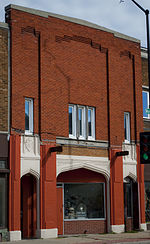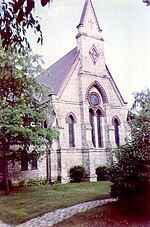Golden Rondelle Theater
1964 New York World's Fair1964 establishments in New York CityBuildings and structures in Racine, WisconsinRelocated buildings and structures in WisconsinTheatres completed in 1964 ... and 4 more
Theatres in WisconsinTourist attractions in Racine, WisconsinUnited States theater (structure) stubsWorld's fair architecture in the United Kingdom

The Golden Rondelle Theater is a historic theater currently located in the administration complex of S. C. Johnson & Son in Racine, Wisconsin. Featuring a radical design, the theater was originally part of the 1964-65 World's Fair before being moved to Racine. At the World's Fair the theater was used to show the award-winning film To Be Alive!. After the fair, the theater was dismantled, shipped to Racine, and used as the basis of a re-designed theater. The design work was by Taliesin Associated Architects, the successor firm to that of Frank Lloyd Wright.
Excerpt from the Wikipedia article Golden Rondelle Theater (License: CC BY-SA 3.0, Authors, Images).Golden Rondelle Theater
15th Street, Racine
Geographical coordinates (GPS) Address Nearby Places Show on map
Geographical coordinates (GPS)
| Latitude | Longitude |
|---|---|
| N 42.71522 ° | E -87.7907 ° |
Address
SC Johnson Headquarters
15th Street
53403 Racine
Wisconsin, United States
Open on Google Maps









